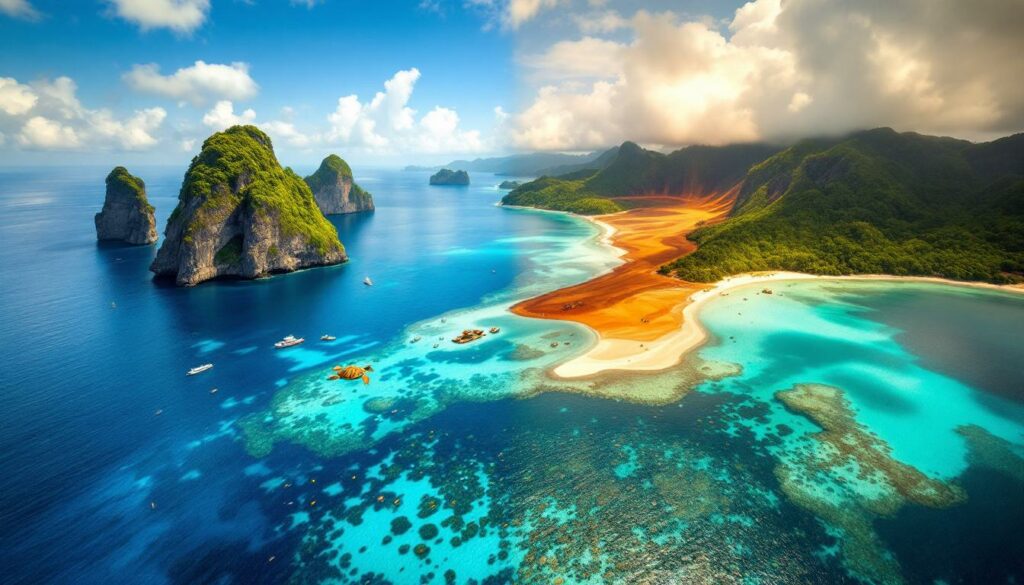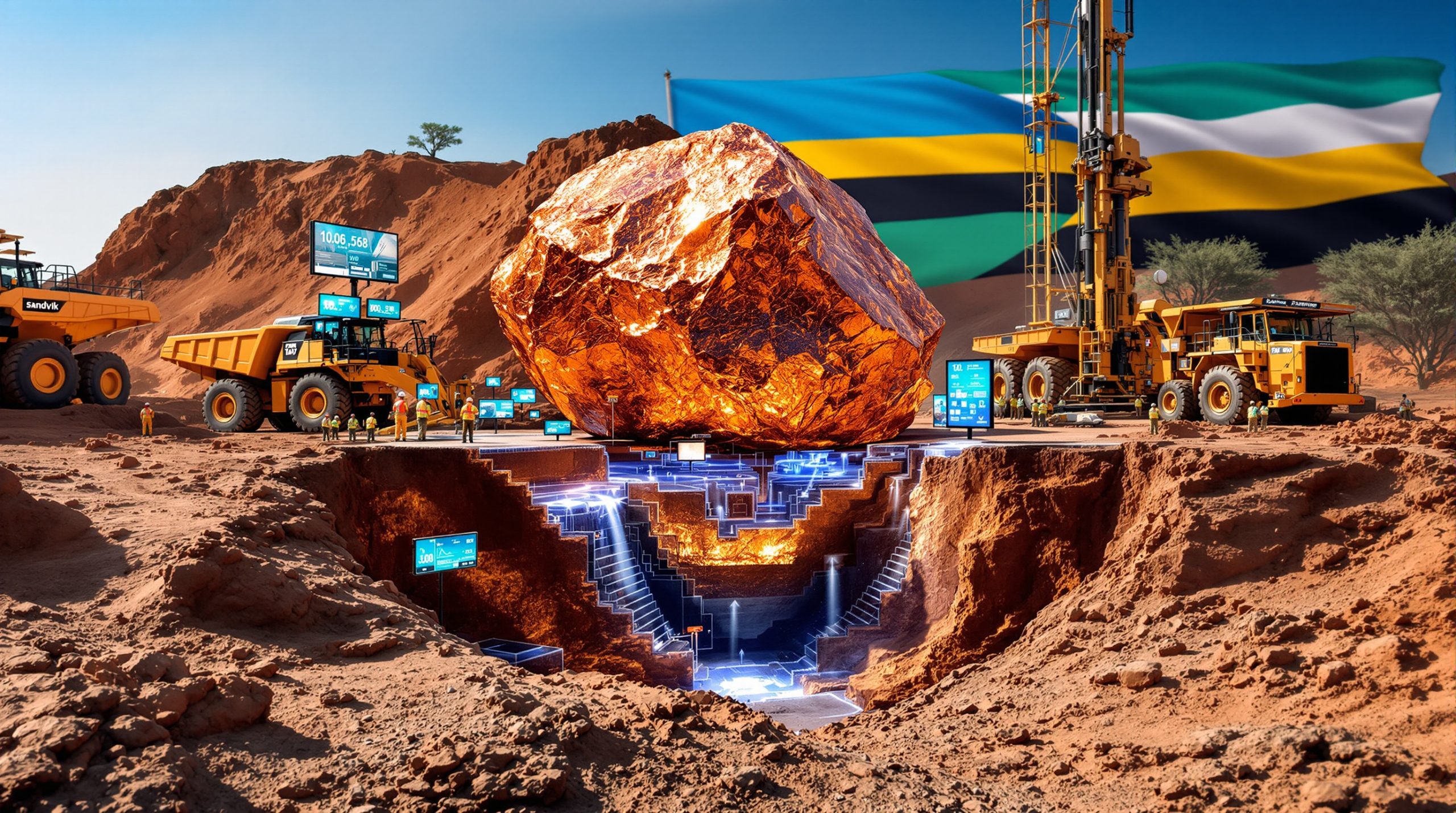Why is Raja Ampat Considered "The Last Paradise on Earth"?
Raja Ampat, an archipelago comprising 1,500 islands, cays, and atolls in Indonesia's eastern West Papua region, represents one of the world's most pristine marine environments. This UNESCO Global Geopark features dramatic limestone karst rock formations that rise majestically from crystal-clear waters, creating a landscape that appears almost otherworldly.
The archipelago's biodiversity statistics are staggering – home to over 75% of the world's known hard-coral species (approximately 600 species), 1,800 different reef fish species, and a sanctuary for five endangered turtle species. This remarkable concentration of marine life has earned Raja Ampat recognition as a global biodiversity hotspot of unparalleled importance.
For local Indigenous Papuans, Raja Ampat (meaning "Four Kings") isn't merely a tourist destination but a vital ecosystem that sustains their livelihoods through fishing and tourism. The name reflects local mythology about four kings who once ruled these islands, adding cultural significance to the ecological treasure.
The Ecological Significance of Raja Ampat's Marine Ecosystem
Raja Ampat's exceptional biodiversity makes it a global conservation priority. Marine biologists consider its reefs among the most diverse on the planet, functioning as a critical breeding ground for endangered marine species and a genetic reservoir for coral reef ecosystems throughout the Indo-Pacific region.
"In remote villages the reef is the supermarket, the bank, and the primary source of protein, with reef fish and shellfish forming the backbone of daily nutrition," explains Australian conservationist Lynn Lawrence of The Sea People organization (ABC News, 21 Jun 2025).
The archipelago serves as a natural laboratory for understanding reef resilience and provides sustainable food sources for local communities. Its intact ecosystem demonstrates how healthy marine environments naturally resist coral bleaching and recover from climate stressors more effectively than degraded reefs.
How is Nickel Mining Threatening Raja Ampat?
The Expansion of Indonesia's Nickel Industry
Indonesia has positioned itself as the world's largest nickel refiner, with the government actively promoting domestic processing since implementing a ban on unprocessed mineral exports in 2014. This policy shift has attracted massive investment from Chinese mining companies and created industrial processing hubs like Weda Bay Industrial Park (IWIP).
The country's strategy aims to leverage its vast nickel reserves to become a key supplier for electric vehicle batteries, positioning Indonesia as essential to the global green energy transition. This economic ambition has driven the expansion of mining operations into previously protected areas, including Raja Ampat.
Current Mining Operations in Raja Ampat
According to recent investigations by Greenpeace Indonesia, nickel mining has already caused significant environmental damage within the UNESCO Geopark. Their research documented at least 550 hectares of deforestation across three islands: Manuran, Gag, and Kawe.
"Forests have been destroyed, and rainwater runoff now carries sediment from the cleared areas. This is causing reef-smothering elevated turbidity in the sea, evident as discolouration of water near jetties and mines," reports Greenpeace Indonesia (ABC News, 21 Jun 2025).
The most significant operation is run by Gag Nickel, a subsidiary of Indonesian state-owned mining company Aneka Tambang. Despite government revocation of four other licenses in the area, Gag Nickel continues to hold an active mining permit. The 309 hectares of forest cleared specifically on Gag Island represents a substantial environmental footprint within this sensitive ecosystem.
What Environmental Impacts Have Been Documented?
Deforestation and Marine Ecosystem Damage
The environmental footprint of nickel mining in Raja Ampat is well-documented through satellite monitoring and field research. Global Forest Watch data shows 262 hectares of forest loss on Gag Island between 2017 and 2024 alone (ABC News, 21 Jun 2025).
This deforestation triggers a cascade of environmental impacts. When tropical forests are cleared, the exposed soil easily erodes during rainfall. The resulting sediment runoff causes elevated turbidity in surrounding waters, visible as discoloration along coastlines near mining operations.
For coral reefs, this sedimentation is particularly devastating. Fine particles smother coral polyps, blocking essential sunlight and preventing them from feeding or reproducing. The disruption of natural water flows and watershed functions further compounds these impacts.
Pollution Concerns Based on Similar Operations
While direct pollution measurements in Raja Ampat are limited, research conducted at Weda Bay Industrial Park (IWIP), where nickel ore from Raja Ampat is processed, reveals alarming pollution patterns that could potentially affect mining sites.
A comprehensive study by Indonesian non-profit Nexus3 in July 2024 found:
- Water samples from rivers serving as drinking sources contained chromium and nickel exceeding safe limits set by the US Environmental Protection Agency
- Blood samples from residents near IWIP showed presence of heavy metals, including arsenic exceeding safe thresholds in 15 people
- Fish caught in Weda Bay contained elevated levels of arsenic and mercury above national safety standards
"The fish samples were taken at the fish landing site, directly from the fishermen's boats — these are the same fish sold at the market," said Yuyun Ismawati of Nexus3, who described a "cocktail of toxic pollutants" difficult to measure with standard benchmarks (ABC News, 21 Jun 2025).
These findings raise serious concerns about similar potential contamination in Raja Ampat as mining operations expand.
Who is Fighting to Protect Raja Ampat?
Local Indigenous Resistance
Indigenous Papuans like Matias Mambraku are at the forefront of conservation efforts. Working as tour guides to promote sustainable ecotourism, they demonstrate how healthy ecosystems can provide sustainable livelihoods without destructive extraction.
"We survived without mining before, and we will continue to survive as long as we protect our homes," states Mambraku, highlighting the deep connection between Indigenous well-being and environmental protection (ABC News, 21 Jun 2025).
Indigenous advocates are pushing for greater participation in decision-making processes affecting their ancestral territories. They work to protect traditional fishing grounds and cultural heritage while organizing community-based conservation initiatives that blend traditional ecological knowledge with scientific approaches.
Conservation Organizations and Researchers
Several organizations are actively working to document impacts and protect Raja Ampat:
- The Sea People, founded by Lynn Lawrence, runs one of Indonesia's largest community-based reef restoration programs (Yaf Keru)
- Greenpeace Indonesia released detailed investigations of mining impacts in June 2025
- Nexus3, an Indonesian non-profit, conducted research on pollution from nickel processing
- Global Forest Watch provides satellite monitoring of deforestation in the region
These organizations combine scientific research, community engagement, and advocacy to create public awareness and pressure for policy change.
Social Media Campaigns and Public Pressure
The #SaveRajaAmpat social media campaign has gained significant traction, demonstrating how digital activism can influence environmental policy. The campaign has:
- Generated nationwide awareness about mining threats
- Pressured the Indonesian government to review mining permits
- Created international solidarity for conservation efforts
- Highlighted the contrast between Indonesia's conservation commitments and mining expansion
This grassroots digital movement played a crucial role in the government's decision to revoke four mining licenses, showing how public opinion can influence environmental governance even in remote regions.
What Actions Has the Indonesian Government Taken?
Permit Revocations and Regulatory Responses
In response to public pressure and environmental concerns, the Indonesian government has taken limited action toward protecting Raja Ampat. The most significant step was revoking four of the five active mining licenses within the UNESCO geopark.
Mines Minister Bahlil Lahadila publicly cited "environmental violations" as justification for the permit cancellations, acknowledging the ecological importance of the region. However, the government maintained the permit for Gag Nickel, the state-owned operation, revealing tensions between environmental protection and economic interests.
Ongoing Challenges and Controversies
Despite these actions, significant challenges remain in securing Raja Ampat's long-term protection:
- The government has previously reactivated revoked mining permits in other regions, raising concerns about the permanence of protection measures
- Environmental agencies have disputed research findings about pollution levels, with local officials questioning the Nexus3 study methodology
- Economic development priorities often conflict with conservation goals, especially as Indonesia positions itself in the electric vehicle supply chain
- Enforcement of environmental regulations remains inconsistent, with limited monitoring capacity in remote areas
"There must be a formal decision to ensure that the revocation is actually carried out," warns Arie Rompas of Greenpeace Indonesia, highlighting concerns about implementation gaps (ABC News, 21 Jun 2025).
How Does Raja Ampat's Situation Reflect Broader Environmental Tensions?
The Green Energy Paradox
Raja Ampat's situation highlights a fundamental tension in the global transition to renewable energy. Nickel is essential for electric vehicle batteries and renewable energy storage, positioning Indonesia's nickel industry as supporting global decarbonization efforts.
Yet mining operations cause significant local environmental damage, creating a "green energy paradox" where environmental harm occurs in the name of sustainability. This contradiction forces difficult questions about who bears the costs of energy transition challenges and whether "green" technologies are truly sustainable when their supply chains involve ecosystem destruction.
The battle to save Raja Ampat from nickel mining exemplifies how the rush to secure materials for clean energy can inadvertently damage the very ecosystems we need to protect in a changing climate.
Indigenous Rights vs. Resource Extraction
The conflict also represents a classic tension between Indigenous rights and resource extraction that plays out globally. Raja Ampat's Indigenous communities depend on healthy marine ecosystems for their physical and cultural survival, with traditional knowledge systems that prioritize sustainable resource use.
Mining operations threaten both environmental and cultural sustainability, yet decision-making processes often exclude Indigenous perspectives. The experiences of communities in Raja Ampat mirror those of Indigenous peoples worldwide who find themselves on the frontlines of conflicts between resource extraction and conservation.
This pattern raises important questions about environmental justice and whether conservation can succeed without respecting Indigenous sovereignty and traditional stewardship.
What Would Sustainable Development Look Like for Raja Ampat?
Ecotourism as an Alternative Economic Model
Raja Ampat has developed a successful ecotourism industry that offers an alternative development path to extractive industries. This approach:
- Generates sustainable income for local communities
- Creates incentives for environmental protection
- Preserves cultural heritage and traditional knowledge
- Distributes economic benefits more equitably
Matias Mambraku's work as a tour guide demonstrates how ecotourism creates direct economic opportunities for Indigenous Papuans while incentivizing conservation. Visitors pay conservation fees that fund marine protected areas, creating a virtuous cycle where environmental protection enhances economic value.
Community-Based Conservation Approaches
Successful conservation in Raja Ampat requires community leadership rather than top-down approaches. Effective models include:
- Indigenous-led marine protected areas that incorporate traditional fishing rights
- Traditional ecological knowledge integration into management plans
- Equitable benefit-sharing mechanisms that ensure conservation supports local livelihoods
- Transparent decision-making processes that respect free, prior, and informed consent
The Sea People's Yaf Keru program exemplifies this approach by combining reef restoration with community involvement, building local capacity for long-term stewardship.
What Can Be Done to Ensure Raja Ampat's Protection?
Policy Recommendations
Effective protection of Raja Ampat requires policy changes at multiple levels:
- Complete revocation of all mining permits within the UNESCO Geopark, including the Gag Nickel operation
- Strengthened environmental impact assessment requirements that account for cumulative impacts
- Independent monitoring of water and air quality with transparent reporting
- Recognition of Indigenous land and sea rights through formal legal frameworks
- Investment in sustainable development alternatives like ecotourism infrastructure and marine conservation
These policy changes would align Indonesia's actions with its commitments to biodiversity conservation and sustainable development.
Individual Actions
Individuals can support Raja Ampat's protection through multiple channels:
- Supporting responsible ecotourism operations that benefit local communities
- Amplifying Indigenous-led conservation campaigns like #SaveRajaAmpat
- Advocating for responsible sourcing of minerals in consumer products
- Raising awareness about the environmental costs of the green energy transition
- Choosing products from companies with transparent and ethical supply chains
Each of these actions contributes to building pressure for sustainable practices in Raja Ampat and similar ecosystems globally.
FAQ: Understanding the Raja Ampat Mining Conflict
What makes Raja Ampat's ecosystem uniquely valuable?
Raja Ampat contains the highest marine biodiversity recorded on Earth, with over 75% of the world's known hard-coral species, 1,800 reef fish species, and five endangered turtle species. Its limestone karst formations are also recognized as globally significant geological features through UNESCO Geopark status.
How does nickel mining impact coral reefs?
Nickel mining damages coral reefs through multiple pathways: deforestation causes sediment runoff that smothers corals; mining operations release heavy metals that can bioaccumulate in marine organisms; and infrastructure development (ports, roads) directly destroys coastal habitats.
Why is Indonesia expanding nickel mining despite environmental concerns?
Indonesia aims to become a global leader in the electric vehicle supply chain by leveraging its vast nickel reserves. The government's ban on raw ore exports in 2014 was designed to develop domestic processing capacity and capture more value from mineral resources, despite environmental tradeoffs.
What health risks are associated with nickel mining and processing?
Research from similar nickel processing areas in Indonesia has documented concerning health impacts, including elevated levels of heavy metals (arsenic, mercury, chromium) in drinking water, fish, and human blood samples. These contaminants are associated with various health problems, including neurological issues and cancer.
Balancing Conservation and Development in Raja Ampat
The battle to save Raja Ampat from nickel mining represents a microcosm of global challenges in balancing conservation with development. As one of Earth's most biodiverse marine ecosystems faces industrialization pressures, the outcome will have implications far beyond Indonesia's borders.
As conservationist Lynn Lawrence notes: "Raja Ampat doesn't need to be admired for what it still has; it needs to be protected for what it still gives." This perspective shifts the focus from viewing Raja Ampat as a pristine paradise to recognizing it as a living ecosystem that sustains both local communities and global biodiversity.
The ongoing struggle between mining interests and conservation efforts in Raja Ampat illustrates the difficult choices facing resource-rich developing nations as they navigate economic development priorities while protecting irreplaceable natural heritage. How Indonesia resolves this tension will serve as an important case study for industry innovation trends and mine reclamation innovations globally.
The need for a comprehensive critical minerals strategy that balances economic development with environmental protection is evident in cases like the mining halt example of Paladin Energy in Namibia, which demonstrates how mining operations can be paused when environmental concerns become overwhelming.
Disclaimer: This article presents the current situation based on reported information as of June 2025. Environmental impacts, government policies, and conservation efforts may evolve. Readers should consult updated sources for the latest developments in this ongoing issue.
Looking for the Next Major Mining Discovery?
Discover why significant mineral finds can lead to substantial market returns by exploring Discovery Alert's dedicated discoveries page, powered by their proprietary Discovery IQ model that transforms complex mineral data into actionable insights. Start your 30-day free trial today at https://discoveryalert.com.au/discoveries/ to position yourself ahead of the market.




